This article serves as a guide for California Coast photography tips, offering insights into the best camera settings for coastal wildlife photography and helping you prepare for capturing the coast’s stunning landscapes and wildlife.
By Guest Contributor Seth Macey
What You’ll Learn in This Article:
- Why California’s coast is a paradise for photographers.
- How to plan a California coastal photography adventure along the Pacific coast, including key gear and tips.
- Stories, advice, and tips for capturing wildlife during a Highway 1 road trip, including humpback whales, sea otters, pelicans, and more.
- Photographing classic cars along the Pacific Coast Highway and capturing iconic landscapes.
- Practical camera settings to elevate your coastal photography.
Why California’s Coast is a Photographer’s Dream
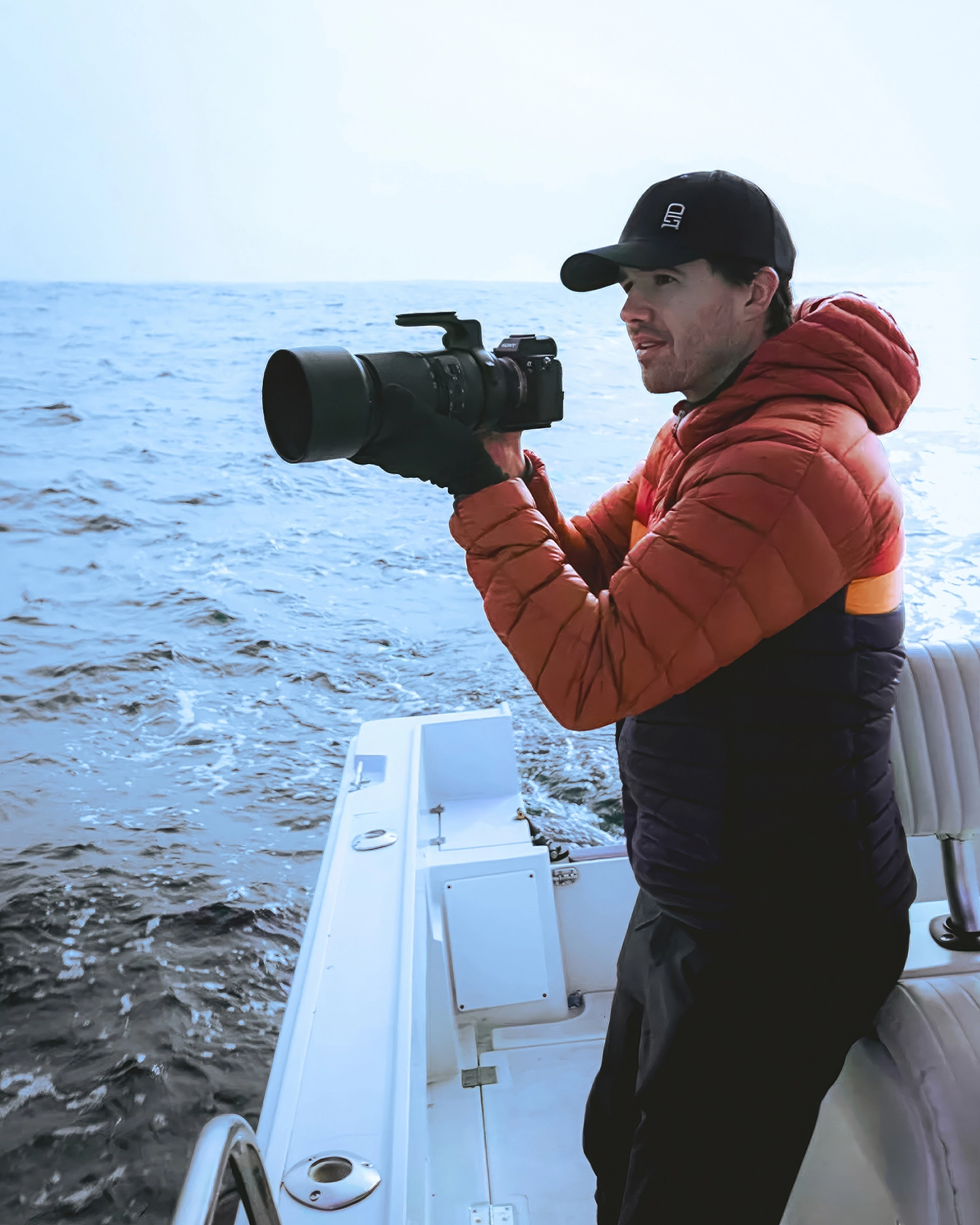
California’s coast is alive with sights and sounds that stir your imagination and challenge your creativity. Towering cliffs meet the endless Pacific, sunlight dances on waves, and drama unfolds around every bend. It’s a haven for California wildlife photography, offering opportunities to capture everything from breaching humpback whales to playful sea otters and breathtaking coastal scenery.
On a recent visit to Monterey, I experienced it all up close. In this post, I’ll share not only what I saw but also my California coastal photography tips and lessons learned behind the lens to help make your next photography trip to this beautiful stretch of coast easier and more enjoyable. Let’s get right into it!
How to Plan a California Coastal Photography Adventure:Packing the Essentials
Great photos are rooted in preparation. Whether you’re planning a session of Highway 1 road trip photography or capturing wildlife, California’s coast is as unpredictable as it is stunning, shifting between sunny skies and foggy mornings. Having the right tools and mindset can transform your experience.
The right gear ensures you’re always ready for the perfect moment. Here’s what I packed for this trip, aiming to capture the best coastal landscapes in California:
Lenses
- For close-ups of wildlife, I relied on the Tamron 150-500mm lens. Its extra focal length gave me the reach I needed to photograph subjects like whales and sea otters, especially when I was restricted to shooting from shore or a boat.
- For landscapes, I used the Tamron 28-75mm F2.8 G2 lens because of its versatility. The 2.8 aperture also gave me the option to capture lifestyle or portrait shots if the opportunity arose.
Accessories
I brought extra batteries, memory cards, and a fluid head tripod. While I photograph handheld most of the time, the tripod was invaluable for stabilizing my shots when filming video or working in low-light conditions.
Clothing
I layered up to prepare for the chilly mornings and gusty winds along the Pacific. A waterproof jacket was essential for unexpected sea spray or light rain, and I paired it with a warm fleece and moisture-wicking base layers to stay comfortable throughout the day.
Safety and Respect
- Road Safety: On Highway 1, pull off only at designated spots or where there is plenty of shoulder. The road can be very winding and blind at times, leaving little room for error, but the scenic value is unmatched.
- Respect Wildlife: Whether it’s sea lions on the docks or otters surfing in the waves, give animals space to behave naturally without interference.
Whale and Wildlife Photography in Monterey Bay
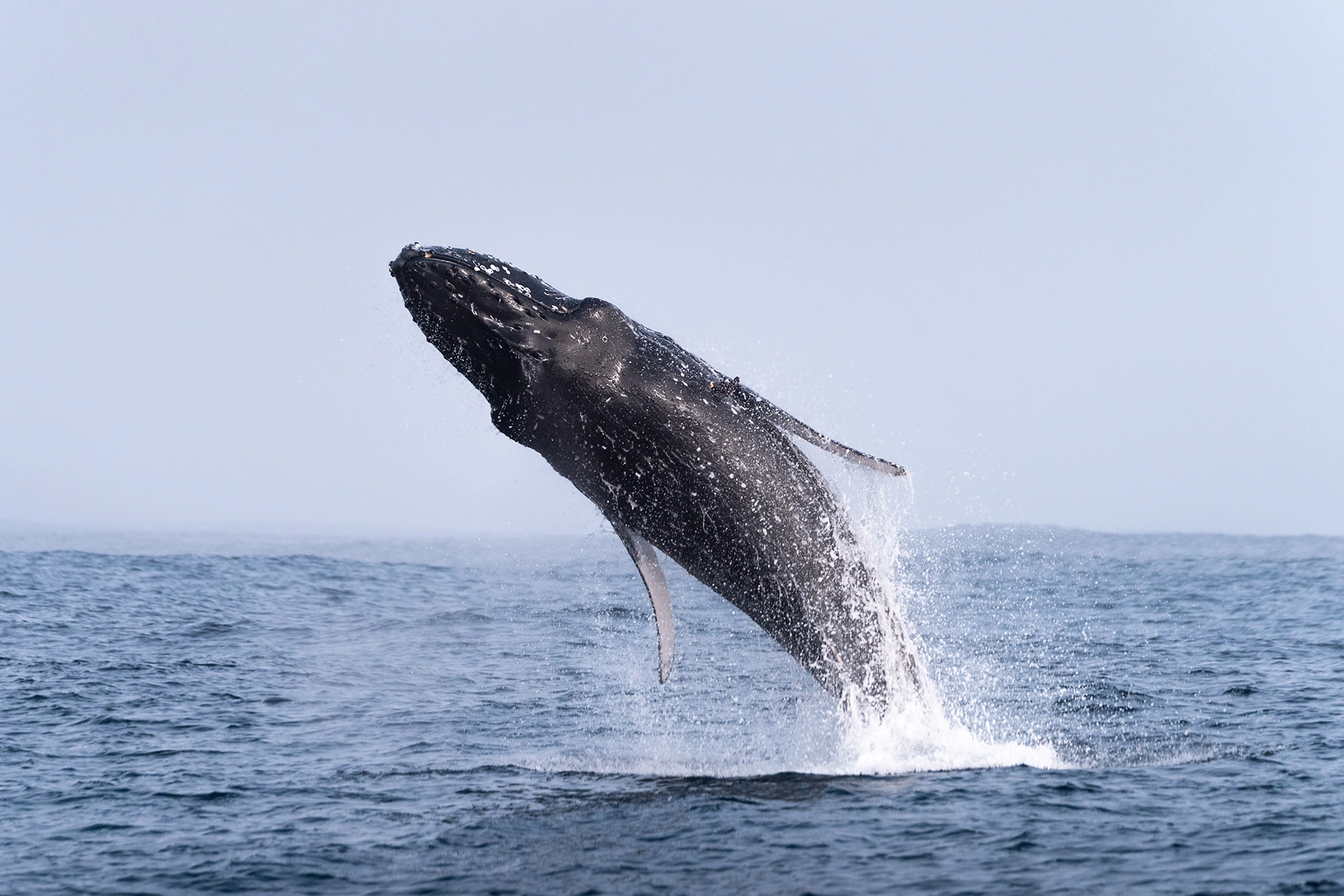
My adventure kicked off with a whale-watching trip, courtesy of my friend Slater Moore, who runs a private whale-watching business out of Monterey. His small boat holds just three people, which made it an intimate experience for me, another friend I was traveling with, and Slater as captain. We set out, and it wasn’t long before we spotted the stars of the show.
Where to Photograph Whales Along California’s Coast
California’s coast offers plenty of great locations for whale watching and photography, such as Point Reyes National Seashore, known for gray whale migrations, and Dana Point, famous for its year-round marine life. However, Monterey Bay stands out as one of the best photo spots along the Pacific Coast Highway, for photographing whales along California’s coast.
What sets Monterey Bay apart is its unique underwater canyon, which creates nutrient-rich waters that attract a variety of whales, including humpbacks, blue whales, and orcas, depending on the season. The bay’s calm waters and abundance of whale-watching tours make it an ideal location for photographers to capture intimate encounters with these majestic creatures, whether from shore or on a boat.
Chasing Humpback Whales
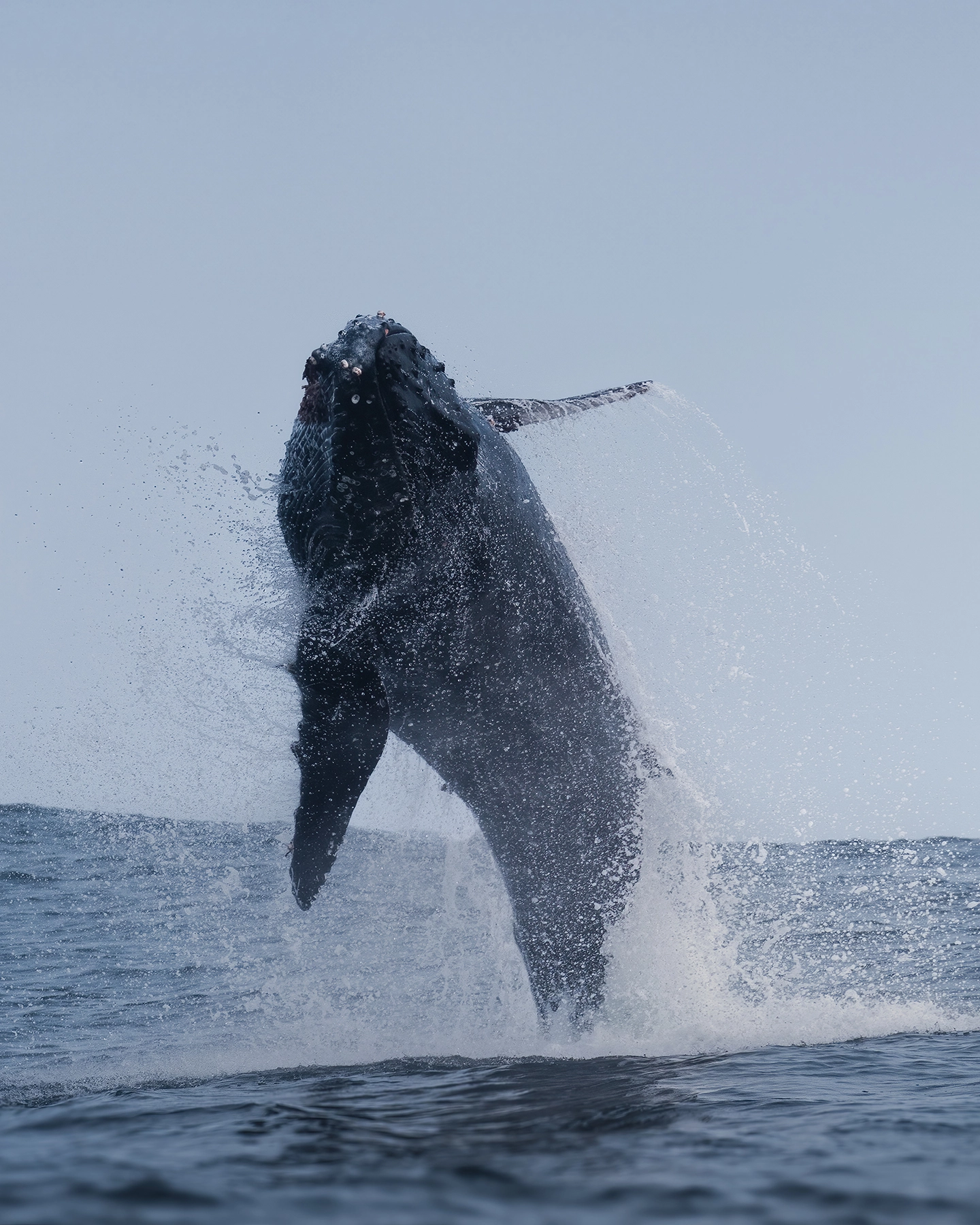
At the helm, Captain Moore spotted a humpback whale breaching over a mile away. I couldn’t believe his precision in locating what had to have been a brief blip on the horizon.
We traveled in its direction, stopped roughly in the area where we had last seen the whale, and suddenly, the whale exploded out of the water just 100 yards from us. It was like watching raw power in motion. The deep, resonating crash of water as it breached, combined with the sight of its enormous body covered in barnacles, left me in awe.
This was my first time on a whale-watching boat, let alone a private one, and the experience was unforgettable. The large swells didn’t sound intimidating until I was out in the open ocean.
I thought my experience photographing from small boats in Ontario would prepare me, but seasickness hit hard. Looking through a viewfinder while the boat rocked was nauseating, so I quickly learned to take breaks and find my balance between shots. For photographers prone to seasickness, this small adjustment can make a world of difference.
The whale’s breach was breathtaking, an enormous animal, the size of a bus, launching out of the water with raw power and speed. The thrill of not knowing where it would surface next only added to the excitement.
Slater told me that having the first whale you’ve ever seen breach so close is an experience many people never get, and I felt incredibly fortunate to witness and capture it on my first outing.
Photography Tips While Whale Watching
The action of a breach happens in a split second, and there’s no time to fumble with settings or hunt through a viewfinder. Over time, I’ve learned a few key techniques that help me nail the shot when the moment strikes. Here’s how I approach it—gear, settings, and all.
- Use a Tamron 150-500mm lens for strong telephoto reach.
- Set a fast shutter speed (e.g., 1/3200 sec) to freeze action like a whale breach.
- Enable burst mode to increase your chances of capturing the perfect moment.
- Shoot from the hip rather than relying on the viewfinder for fast, unpredictable subjects.
- Track the whale with your eyes, not the camera, and aim your lens generally in that direction.
- Stay slightly zoomed out to keep the entire subject in frame—cropping later is always an option.
Encounters in the Harbor
Sea Lions
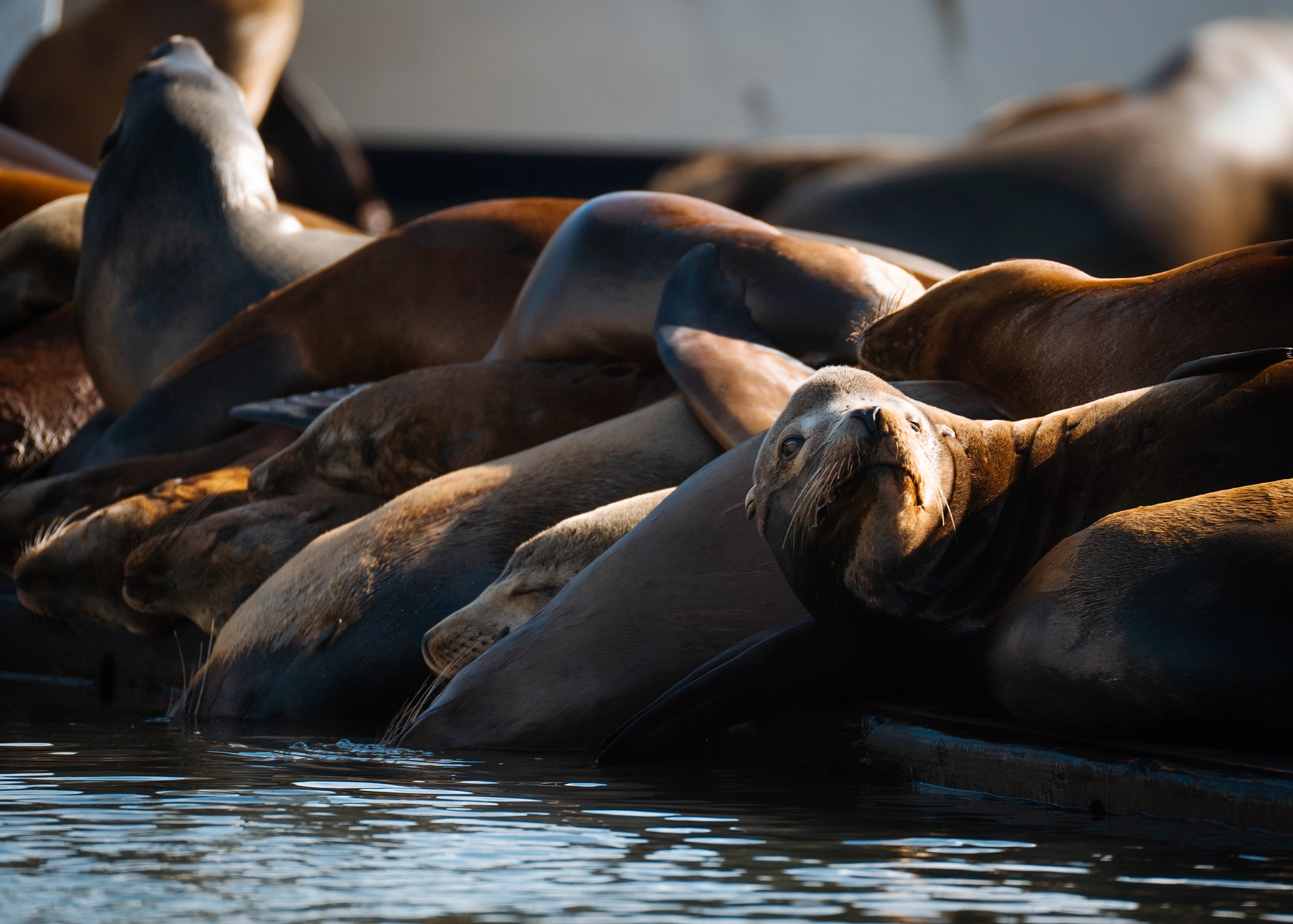
Back in the calm confines of the Moss Landing harbor, I was amazed by the abundance of wildlife. I was specifically interested in the sea lions crowding the docks, piling on top of each other under the midday sun.
Steam rose off their bodies in the cool air, creating an almost mythical scene. Their barking echoed across the water, full of personality and drama. Using the Tamron 150-500mm, I zeroed in on a cluster of sea lions, capturing the energy and chaos of the harbor.
Pelicans

Among several bird species in the area, pelicans stood out as particularly fascinating subjects to me. With their cavernous mouths and striking blue eyes, they exuded a prehistoric elegance.
One of my tips for photographing pelicans is to isolate details that tell a story. For the pelicans, I focused on the curve of their necks and the intensity of their gaze, cropping in tight to emphasize these features.
As wildlife photographers, it’s easy to focus solely on capturing an animal in its entirety, and while that has its value, there’s often more to explore. Sometimes the most striking wildlife photos come from homing in on a single detail and letting it speak for itself.
Observing Playful Sea Otters

Further out, I spotted rafts of sea otters bobbing in the surf. It was a bright, sunny day, and while midday light can be tricky, I’ve always been impressed with how the Tamron 150-500mm performs in these conditions.
The otters floated in groups, holding hands as the waves carried them gently over the swells. Occasionally, one would peel off to hunt, disappearing beneath the surface and returning with food, often urchins, clutched in its paws.
The constant somersaults were endlessly amusing. I couldn’t help but wonder why they do this and how they don’t get dizzy!
One particularly memorable photograph shows an otter mid-somersault, curled into a furry ball with bright blue eyes. It didn’t seem to mind our boat nearby, continuing its playful antics as if we weren’t even there.
As someone with plenty of experience photographing river otters back home, I was thrilled to finally witness sea otters in the wild. Despite their similarities, they’re so different in size and behavior. River otters have always been my favorite animal, so this moment felt especially meaningful.
Pro Tip: Use image stabilization VC Mode 1 for Crisp, Stable Shots.
Even with calm waters, photographing sea otters and focusing on animals can be challenging. My best advice for anyone new to this is to be patient with yourself and take advantage of the VC image stabilization option 1 on the Tamron 150-500mm for stabilization. While I didn’t capture the “perfect shot,” if such a thing even exists, I was just happy to witness a sea otter in its natural habitat, let alone photograph one.
The incredible density of their fur, the thickest of any animal in the world (1 million hair follicles per square inch), was a detail I was able to highlight thanks to the lens. Moments like these remind me that sometimes, the experience itself is the real reward.
Monarch Butterflies in Pacific Grove

Another highlight of my trip was visiting the Monarch Grove Sanctuary in Pacific Grove, a charming town on the Monterey Peninsula. This sanctuary is a vital overwintering site for monarch butterflies, where thousands cluster on pine, cypress, and eucalyptus trees from October through February. Their wings shifted from muted orange to brilliant, luminous hues depending on the light, creating a truly magical sight.
I used the Tamron 150-500mm to capture the intricate details of their wings, highlighting their delicate beauty. What struck me most was the peaceful atmosphere where visitors spoke in hushed tones, as if in reverence for the fragile monarchs.
However, longtime visitors noted and spoke of dwindling numbers in comparison to previous years, a stark reminder of the environmental challenges this species faces. The sanctuary plays a crucial role in providing a haven for these butterflies, underscoring the importance of preserving such spaces for future generations.
Highway 1 and Coastal Road Trip Photography
Highway 1 is a legendary road trip for a reason. It offers some of the best photo spots along the Pacific Coast Highway, with every turn revealing dramatic cliffs plunging into the ocean or sprawling beaches. From Monterey to Big Sur, it offers some of the most scenic coastal road trips California can boast. Iconic stops like Bixby Creek Bridge and the Lone Cypress are must-haves on any Pacific Coast Highway photo itinerary.
Driving a Classic Car
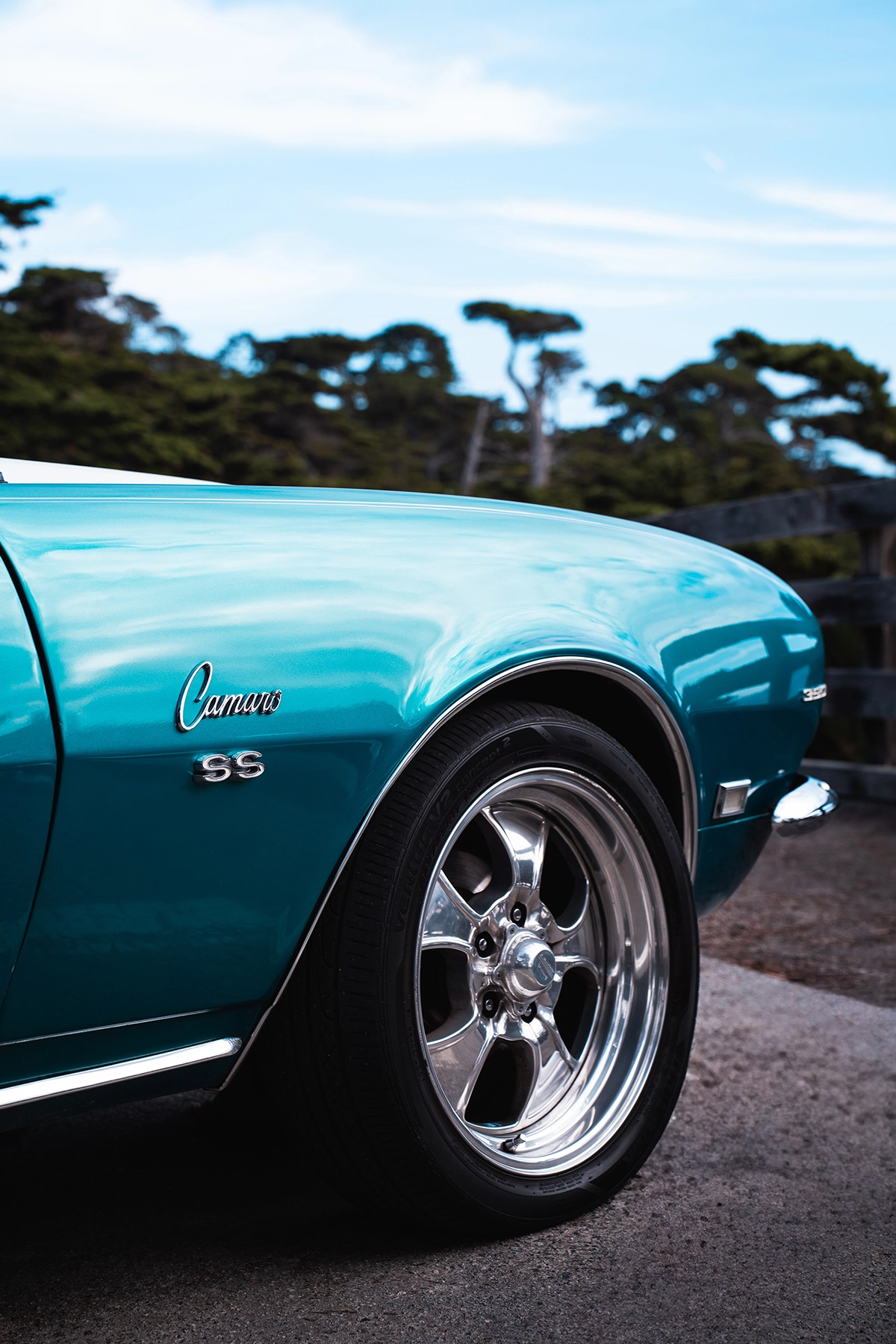
To add an extra layer of charm to the experience, we rented a 1968 Chevy Camaro SS convertible from Monterey Touring Vehicles. Driving the Camaro down Highway 1 felt like stepping into a movie or a song lyric. This is a dream opportunity for anyone passionate about classic car photography along Highway 1.
I can still feel the cool, salty air mixed with the warmth of the sun as my camera sat in my lap. Sharing the drive with good friends made it even more memorable, as we took turns behind the wheel and captured moments together.
The turquoise-colored car contrasted beautifully with the wet asphalt, yellow road lines, and terra-cotta cliffs of Big Sur. My favorite shot involved coordinating with friends to capture the car in motion as it crossed Bixby Creek Bridge.
Bixby Bridge
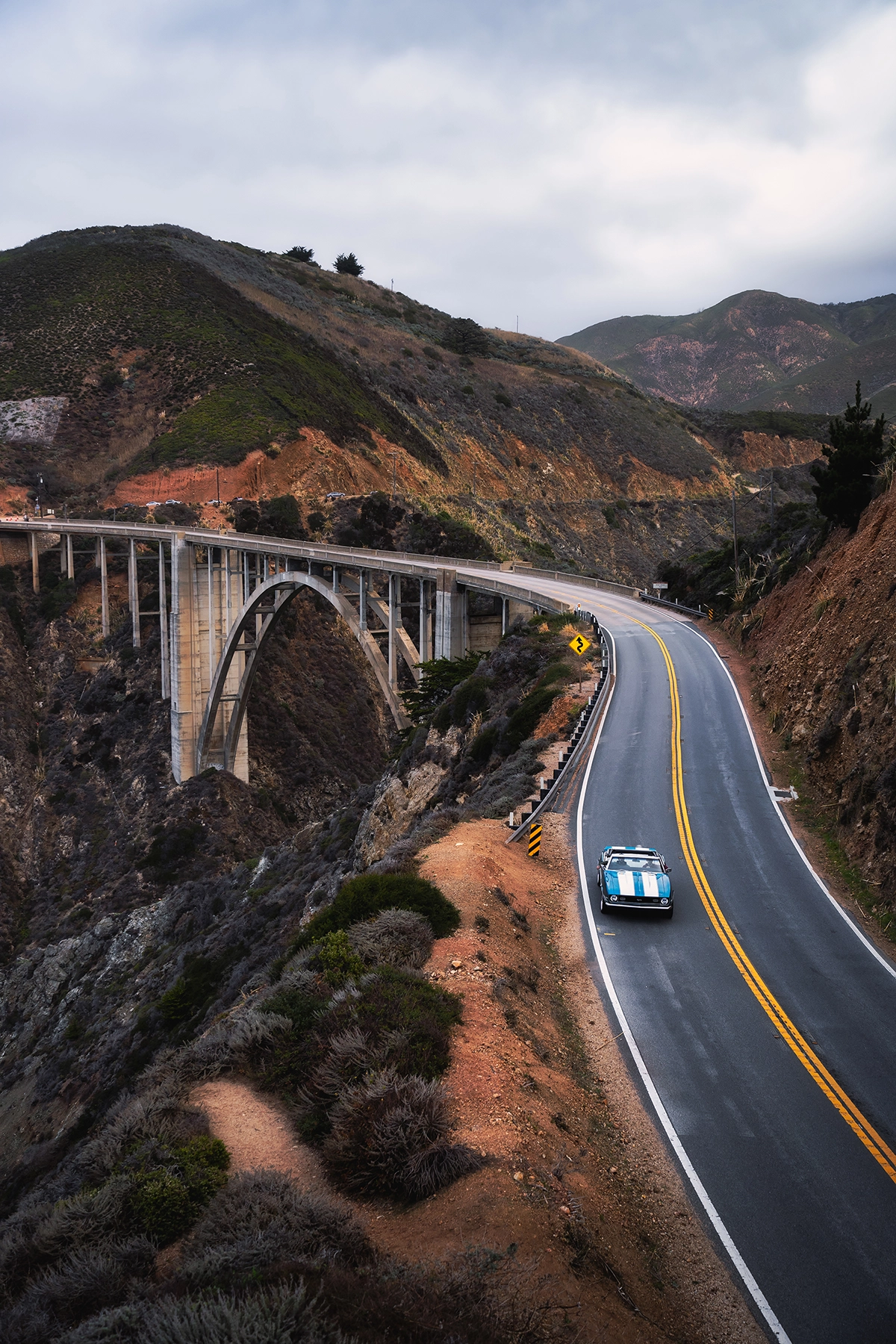
From an elevated vantage point, I framed the car, bridge, and dramatic backdrop into one cohesive composition. Planning this shot was key, and choreographing movements with friends allowed me to achieve something I couldn’t have done solo.
The Tamron 150-500mm lens was a game-changer for capturing distant wildlife, while in instances like this, the 28-75mm lens gave me the versatility to frame iconic landscapes like Bixby Bridge with precision.
If you plan to stop for photos along Highway 1, always prioritize safety. Look for pull-offs with plenty of shoulder space, as the winding roads and blind corners can be dangerous.
Photographing the Lone Cypress
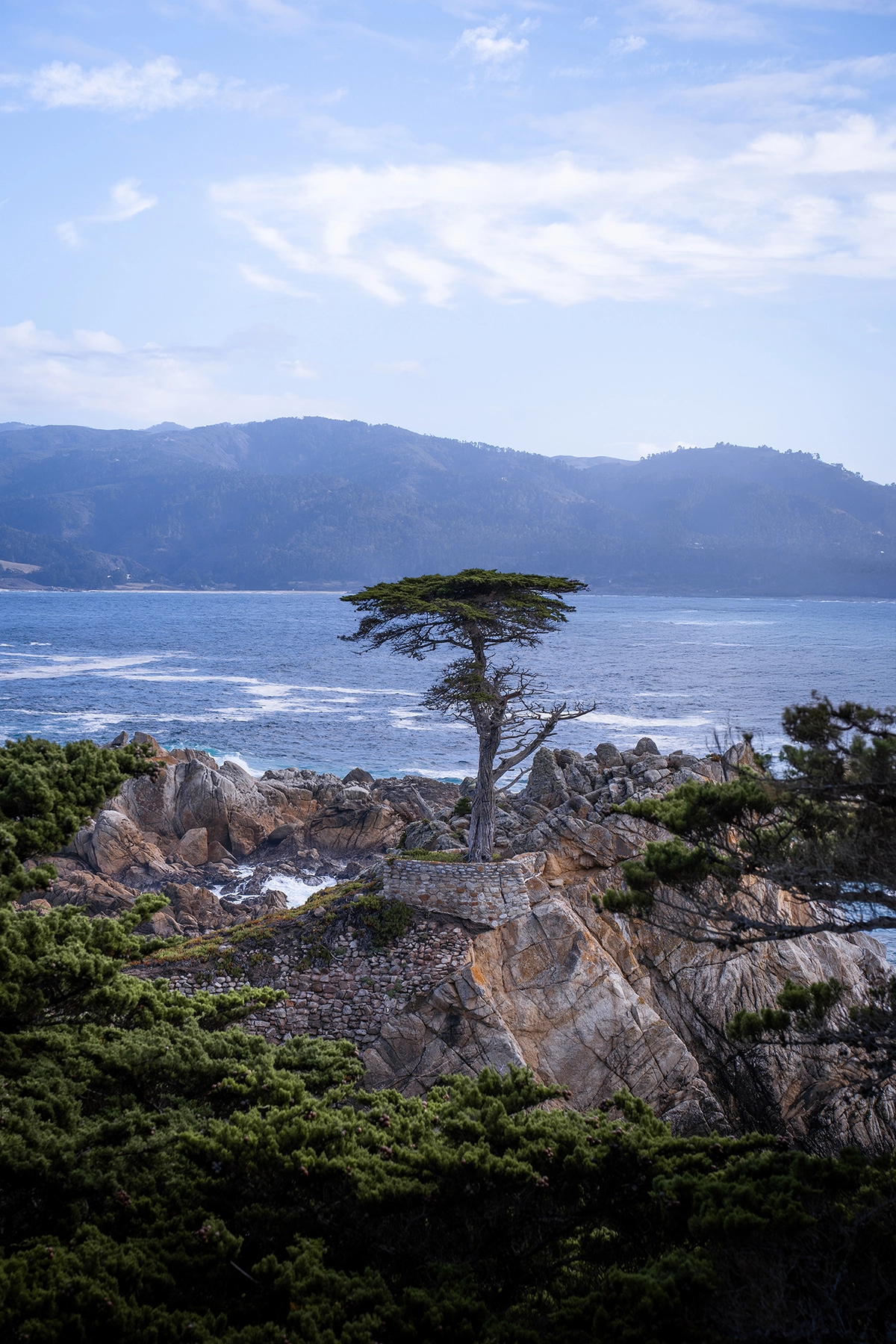
No Highway 1 photography road trip would be complete without a visit to the Lone Cypress. Perched on a rocky ledge overlooking the ocean, this iconic tree has stood for over 250 years, its resilience aided by deep roots and stabilizing cables that protect it from harsh coastal winds.
To capture this legendary shot, you’ll need to detour off Highway 1 and enter 17-Mile Drive, a scenic toll road in Pebble Beach where the Lone Cypress is one of the most celebrated stops.
From the designated pull-off, I framed the windswept branches and rocky ledge against the vast ocean backdrop, using the Tamron 28-75mm G2 lens to capture its timeless silhouette. The Lone Cypress is a testament to endurance and a must-see for any photographer planning a quick and easy detour during a Highway 1 photography road trip.
Final Reflections on My California Coastal Photography Tips
California’s coast is more than a destination; it’s a canvas for creativity. From the raw power of breaching whales and wildlife along the California coast to the quiet elegance of the Lone Cypress, every moment offers a chance to capture nature’s beauty and tell a story through your lens.
Whether you’re planning a Pacific Coast Highway photo itinerary or searching for the best coastal landscapes in California, I hope these California coastal photography tips and experiences will help you make the most of this breathtaking destination.
Learn about Tamron lenses and more at an authorized Tamron dealer near you or visit the TAMRON Store.
About Seth Macey
Seth is a wildlife and landscape photographer based in Ontario, Canada. Seth spends most of his time behind the lens immersed in nature, learning the land, researching, and tracking animal subjects. He is also the co-host of the Photographer Mindset Podcast, sharing ways in which listeners can build their mental fortitude, develop out-of-the-box thinking strategies, and work efficiently towards their own versions of success in photography.
Instagram: @sethmacey
Website: https://www.sethmaceyphotography.com
